Student Wellbeing

Prep Community SPOTLIGHT
In the Prep Community, we have been learning about our feelings and how they can change depending on whether we’re having a good day or a bad day.
We’ve discovered that it’s okay to have bad days, and there are things we can do to help ourselves feel better. We have talked about how important it is to speak to someone we trust when we’re feeling upset or overwhelmed. We also explored different ways to manage our emotions by using the Positive Coping Cards. These cards gave us helpful ideas and strategies that we can use to feel calm, happy, and in control.
It’s been a great way to learn how to take care of our feelings and support each other.
We have also been practicing positive self-talk. Positive self-talk helps us cope with negative thoughts, emotions, and challenging situations. The Preps have been learning a little chant that we can sing to ourselves to help us try something new, or to keep going when things get hard.
Here’s the chant – maybe you can sing it too when things feel tough:
I can do it, yes I can!
I will try and do my best.
When it’s hard, I won’t give up, I’ll keep going — step by step!
Why Is Student Wellbeing Important?
“Wellbeing and a strong sense of connection, optimism and engagement enable children to develop a positive attitude to learning”
DET 2009, p. 10
The Australian Professional Standards
for Teachers (AITSL) highlight how wellbeing is critical for learning and student engagement. In summary, it outlines four key ideas.
Take a look at these four key ideas...
Everyone matters: Wellbeing is a shared responsibility — students, educators, leaders, families and communities all play a role in supporting each other.
Wellbeing boosts learning: Programs that promote social and emotional health strengthen relationships and help students succeed academically.
Teachers need care, too: Teaching is demanding. Schools need to support teacher wellbeing by offering time‑efficient practices and focused professional learning that helps educators help others.
Choose wisely and assess: It’s important to select wellbeing programs that align with school needs and to measure their impact so the efforts really support the whole school community.
In short, the AITSL Standards stress that by working together as a school community, we can create a positive and supportive environment that prioritises the wellbeing of all — students, staff and families alike.
Please see the link below for further information:
https://www.aitsl.edu.au/research/spotlights/wellbeing-in-australian-schools
If your child requires any wellbeing support, please do not hesitate to contact me.
Warm Regards,
Stephanie Stedman
Student Wellbeing and Learning Diversity Leader




